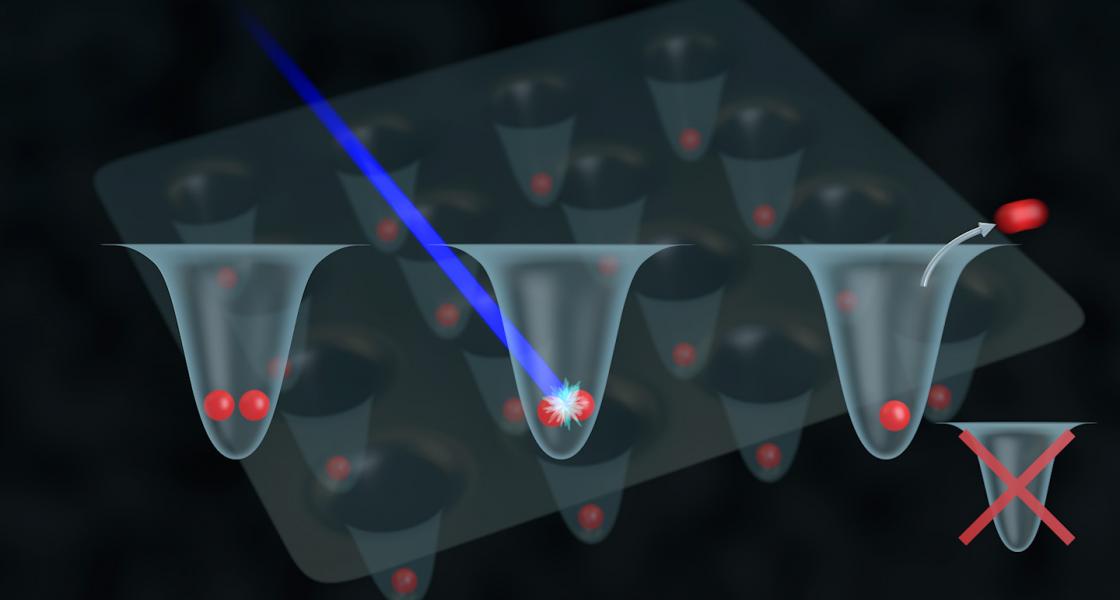Graduate student Brian Lester of the Regal group has taken an important step toward building larger, more complex systems from single-atom building blocks. His accomplishment opens the door to advances in neutral-atom quantum computing, investigations of the interplay of spin and motion as well as the synthesis of novel single molecules from different atoms.
What Lester did was to create a 2 x 2 array of independent optical tweezers (traps), each containing a single neutral rubidium atom. He had to use some interesting physics to get the new system to work because previously anytime two atoms ended up in a single trap during loading, they would collide, and the energy gained during the collision would knock both atoms out of the trap. If enough atoms entered the trap during each loading cycle, the loss of pairs would result in a single atom remaining in a trap in about 50% of the loading attempts.
Then, researchers in New Zealand showed that, with the right set of experimental conditions, the atom-atom collisions could be used to preferentially remove just one atom from the trap. At JILA, Lester and his colleagues adapted these controlled collisions into an efficient and rapid technique to prepare arrays of atoms. In the process, they discovered precisely how close they could bring the traps together before the multiple traps complicated the process and reduced the efficiency of trap loading. Lester’s colleagues included Niclas Luick (Universität Hamburg), newly minted Ph. D. Adam Kaufman (now at Harvard), Collin Reynolds (Seagate Technologies), and Fellow Cindy Regal.
The change that Lester implemented to his experiment was adding another set of laser beams to the part of the experiment where the atoms are loaded into the traps. This set-up allowed the researchers to adjust the beams to increase the probability of losing only one atom from each trap. Then, as long as the traps were at least 1.7 µm apart, the new beams made it possible to end up with a single atom per trap 90% of the time.
In more than 60% of the experiments with the new setup, four traps in the 2 x 2 array were filled with a single atom in less than 170 ms. This performance is a significant improvement over previous attempts to fill a small array of independent optical tweezers. With this experiment, the group has also gained a better understanding of the physics involved in assembling quantum matter from single atoms held in individual optical tweezers.
This experiment is an important step to realizing the benefits of using an array of optical tweezers to study larger systems of atoms, including the ability to adjust the traps and assemble different neutral atoms into more complex systems.—Julie Phillips



 The Physics Frontiers Centers (PFC) program supports university-based centers and institutes where the collective efforts of a larger group of individuals can enable transformational advances in the most promising research areas. The program is designed to foster major breakthroughs at the intellectual frontiers of physics by providing needed resources such as combinations of talents, skills, disciplines, and/or specialized infrastructure, not usually available to individual investigators or small groups, in an environment in which the collective efforts of the larger group can be shown to be seminal to promoting significant progress in the science and the education of students. PFCs also include creative, substantive activities aimed at enhancing education, broadening participation of traditionally underrepresented groups, and outreach to the scientific community and general public.
The Physics Frontiers Centers (PFC) program supports university-based centers and institutes where the collective efforts of a larger group of individuals can enable transformational advances in the most promising research areas. The program is designed to foster major breakthroughs at the intellectual frontiers of physics by providing needed resources such as combinations of talents, skills, disciplines, and/or specialized infrastructure, not usually available to individual investigators or small groups, in an environment in which the collective efforts of the larger group can be shown to be seminal to promoting significant progress in the science and the education of students. PFCs also include creative, substantive activities aimed at enhancing education, broadening participation of traditionally underrepresented groups, and outreach to the scientific community and general public.